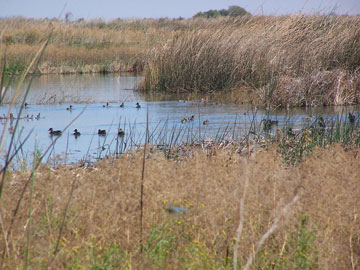Conserving America’s Wetlands 2007:
Three Years of Progress
Implementing the President’s Goal
Perspective
Federal agencies accomplished many tasks this year as they moved closer to the President's wetlands goal. Each of the agencies developed creative solutions, with particular emphasis on public-private partnerships and cooperative conservation.
Progress toward the President's Earth Day goal is supported by over $994 million in the FY 2008 President's Budget specifically for increasing the quality and quantity of wetlands in America (Figure 5).

Cooperative conservation continues to be a successful means of accomplishing the President's Wetlands goal. Voluntary programs that work directly with individual landowners, including Partners for Fish and Wildlife (FWS), and the Wetlands Reserve and Conservation Reserve programs (USDA), continue to be key to restoring, improving, and protecting wetlands.
Large-scale ecosystem restorations in areas such as the USACE Civil Works projects in South Florida and coastal Louisiana continue to help address coastal wetlands issues. Holistic approaches are employed to restore these critical habitats. Integrating wetlands restoration into the larger recovery plans for the Gulf Coast in the aftermath of Katrina and other hurricanes makes good ecological sense, but it also makes good economic sense. Conserving and restoring wetlands is not only critical for recovery efforts along the Gulf Coast, but is also an important part of our national approach to community planning and development, as more than half of the population lives in coastal counties.
Increased Federal attention to wetlands efforts has heightened public awareness of the importance of wetlands and their role in sustaining a resilient coast. The devastating hurricanes of 2005 have served to increase the sense of urgency in the American public for conserving, restoring, and creating coastal wetlands. An informed public working in partnership with Federal, state, tribal, and local agencies provides an opportunity to ensure wetlands are conserved for future generations.
 |
| Early fall migrants on recently enhanced wetland on the Frasher Farms, North San Joaquin Valley, California. (FWS) |
These collaborative conservation and stewardship efforts depend on accurate, timely, and reliable data that support a common operating picture of where restoration efforts have been realized, are in progress, or need to be initiated. Although the National Wetlands Inventory and National Resources Inventory provide a base of information for this purpose, an integrated national, regional, and local information system to capture, manage, and share the site information on restoration efforts would make this information more valuable for decision makers. This system could provide real-time access to information that can be viewed and validated by a community of partners in the context of map location and landscape. To satisfy these requirements the system must be geospatially enabled with geographic information systems (GIS) technology and it must take advantage of the power of the Internet for promoting collaboration. Such a system could significantly improve the tracking of accomplishments, management of data, dissemination of information, environmental analyses, and decision making. Such a system will allow state and Federal agencies and private sector partners to share GIS-based information concerning wetlands. Decision makers and managers at all levels inside and outside the government will be able to make better informed and quicker wetland decisions.
We estimate that the President's Earth Day 2004 goal to create, improve, and protect at least three million wetland acres will be achieved a year earlier than our target date of Earth Day 2009. To ensure that the strides made in achieving the wetlands goal not only continue but increase, one next step would be to lay the foundation to make sure that all decision makers, including individual citizens, have browser-based access to the information they need to track past accomplishments and make the coordinated strategic decisions that will ensure our Nation's wetland and economic bases continue to expand.










